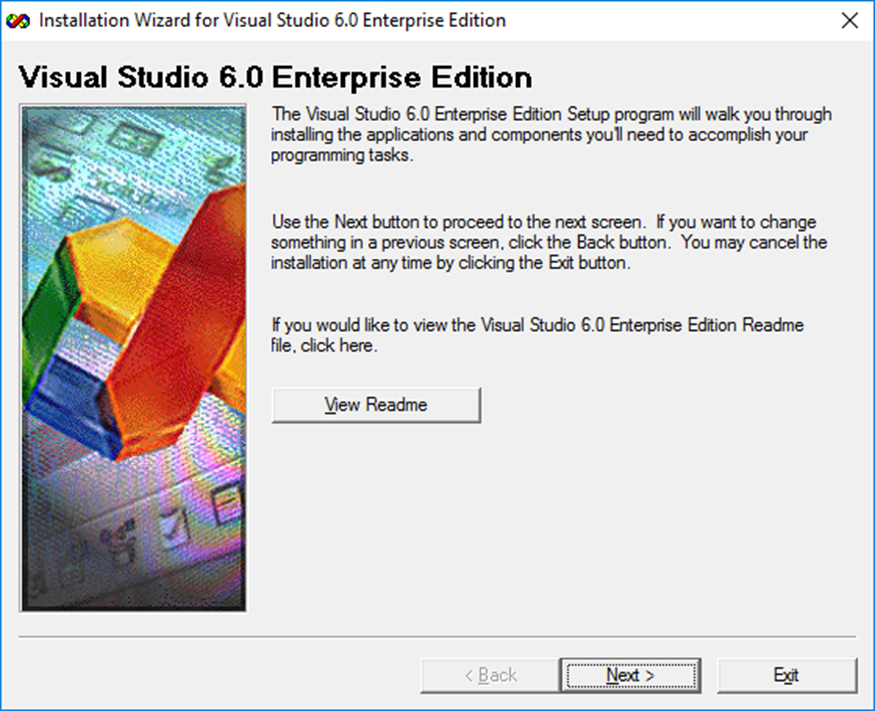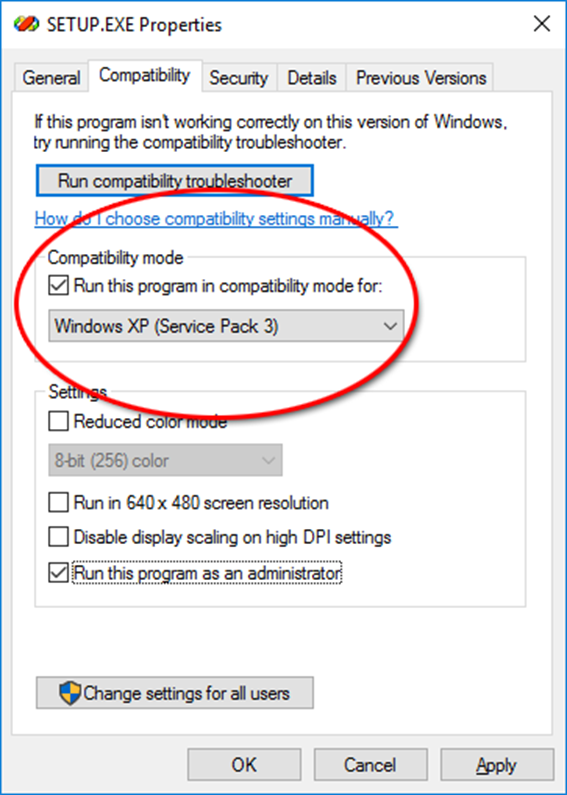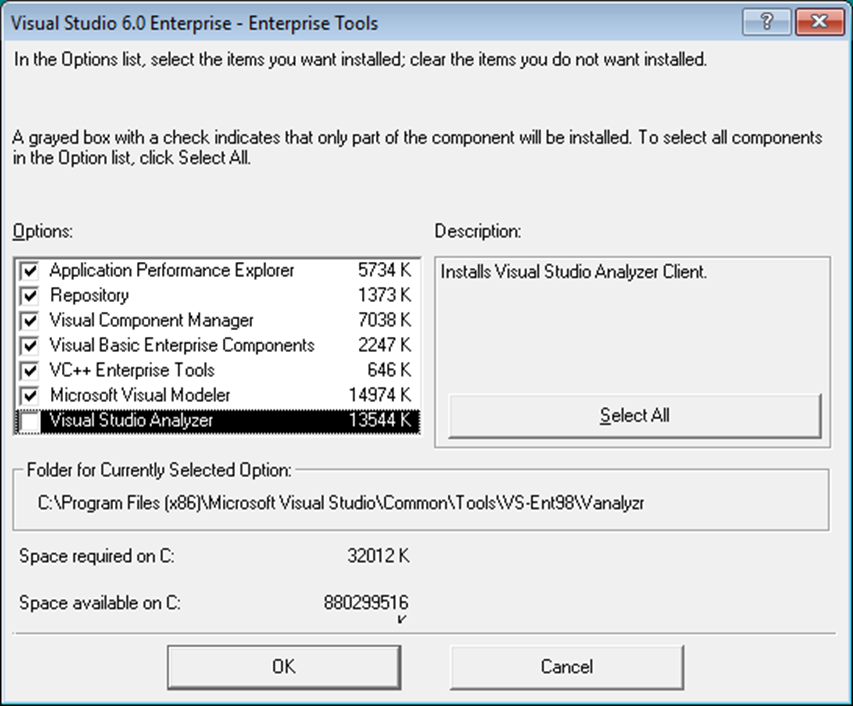Install Visual Studio 6.0 on Windows 10
A
tutorial for installing Visual Studio 6.0 on Windows 10
This article is a step by step process to install Visual Studio 6.0 on
Windows 10. This article references the Enterprise edition of Visual Studio;
however the same approach should work with the Professional version as well. It
goes over how to clean up previous attempts if you've tried installing and
failed, goes through running the setup wizard, and tells you which settings to
disable.
Introduction
Yes, you read that title correctly, this article
describes how to install Visual Studio 6.0 on Windows 10. Visual Studio 6.0 is
still widely used around the globe, and there is a need to provide support for
legacy applications and developers who still want to use this platform. Also,
being the old timer that I am, I still like using Visual Studio 6.0 whose
interface was specifically designed for C++ development. Sure, I admit I might
be a little resistant to change, but I also find the MFC wizards are more C++
friendly and I like the ability to record macros which was no longer supported
with newer versions of Visual Studio.
I have read several articles on this subject, most
are good but seem to be incomplete or missing one or two key elements. I wanted
to document what I have discovered through trial and error to be the best
approach for installing Visual Studio 6.0 on later versions of Windows without
the need for a 3rd party tool or installer.
Clean Up Previous
Attempts
If you are reading this article, you have no doubt
already attempted to install Visual Studio 6.0 on Windows 10 already and it has
failed. If this is the case, you will need to do some manual cleanup first
before we get started. Follow these steps to manually clean up any previous
installation attempts:
Delete Installation
Folders
You will need to remove any installation folders
from previous installation attempts, they are usually located under C:\Program Files (x86) folder for 64-Bit OS
and C:\Program Files folder on 32-Bit OS. Note: If you have installed Visual Studio 2017, make
sure you do not touch the C:\Program Files
(x86)\Microsoft Visual Studio\2017 folder.
·
C:\Program Files (x86)\Microsoft Visual
Studio\Common
·
C:\Program Files (x86)\Microsoft Visual Studio\MSDN
·
C:\Program Files (x86)\Microsoft Visual
Studio\MSDN98
·
C:\Program Files (x86)\Microsoft Visual Studio\VB98
·
C:\Program Files (x86)\Microsoft Visual Studio\VC98
·
C:\Program Files (x86)\Microsoft Visual
Studio\*.HTM
·
C:\Program Files (x86)\Microsoft Visual Studio\*.TXT
·
C:\Program Files (x86)\Common Files\Microsoft
Shared\MSDesigners98
·
C:\Program Files (x86)\Common Files\Microsoft
Shared\MSDN
·
C:\Program Files (x86)\Common Files\Microsoft
Shared\VS98
·
C:\Program Files (x86)\Common Files\Microsoft
Shared\Wizards98
Remove Registry
Entries
You will need to run regedit.exe and delete the following keys if they
exist:
·
HKEY_LOCAL_MACHINE\Software\Microsoft\DevStudio
·
HKEY_LOCAL_MACHINE\Software\Microsoft\HTML Help
Collections
·
HKEY_LOCAL_MACHINE\Software\Microsoft\MSVSDG
·
HKEY_LOCAL_MACHINE\Software\Microsoft\Visual
Basic\6.0
·
HKEY_LOCAL_MACHINE\Software\Microsoft\Visual
Component Manager
·
HKEY_LOCAL_MACHINE\Software\Microsoft\Visual
Modeler
·
HKEY_LOCAL_MACHINE\Software\Microsoft\VisualStudio\6.0
·
HKEY_LOCAL_MACHINE\Software\Wow6432Node\Microsoft\DevStudio
·
HKEY_LOCAL_MACHINE\Software\Wow6432Node\Microsoft\HTML
Help Collections
·
HKEY_LOCAL_MACHINE\Software\Wow6432Node\Microsoft\MSVSDG
·
HKEY_LOCAL_MACHINE\Software\Wow6432Node\Microsoft\Visual
Basic\6.0
·
HKEY_LOCAL_MACHINE\Software\Wow6432Node\Microsoft\Visual
Component Manager
·
HKEY_LOCAL_MACHINE\Software\Wow6432Node\Microsoft\Visual
Modeler
·
HKEY_LOCAL_MACHINE\Software\Wow6432Node\Microsoft\VisualStudio\6.0
·
HKEY_CURRENT_USER\Software\Microsoft\DevStudio
·
HKEY_CURRENT_USER\Software\Microsoft\MSVSDG
·
HKEY_CURRENT_USER\Software\Microsoft\Visual
Basic\6.0
·
HKEY_CURRENT_USER\Software\Microsoft\Visual Modeler
·
HKEY_CURRENT_USER\Software\Microsoft\VisualFoxPro
·
HKEY_CURRENT_USER\Software\Microsoft\VisualStudio\6.0
Prepare Setup Files
First, you are going to need a copy of Visual
Studio 6.0 setup files. I am going to assume that you have obtained or
own a legal licensed copy of this already. This article references the Enterprise edition
of Visual Studio; however the same approach should work with the Professional version
as well, now let's begin.
Step 1
You will to need to create a folder either on your
desktop or some other location that we can use to copy the installation files
to. The reason for this is some of the files will need to be modified or
edited. Let's create a folder on your desktop and call it Setup. Go to your installation CD and copy the contents
to this folder. If you have multiple CDs, copy each one starting with the first
one to the Setup folder, you can skip
over files with duplicate names when prompted to overwrite.
Step 2
Edit the file called SETUPWIZ.INI and under the section called [setup
wizard], change the entry for VmPath=ie4\msjavx86.exe. If this
entry does not exist, you can skip this step. We need to remove the value ie4\msjavx86.exe form
this entry so it will create an empty environment variable during installation.
This will stop the setup wizard from looking for and installing this very old
version of MS Java on our system. After removing this entry, your INI file
entry should now look like this:
Step 3
Go to the Setup folder we
created on our Desktop and locate the file SETUP.EXE. Right
click on this file and choose Properties. Select the Compatibility tab
and check to box Run this program in compatibility mode for: and
set the value to Windows XP (Service Pack 3). Also make sure you
check the box Run this program as an administrator and press
the Apply button. You can also use the Service Pack 2 option,
either setting should work.
Run Setup Wizard
Now we should be ready to begin the installation.
From our Setup folder on the Desktop, right click on SETUP.EXE and choose Run as administrator.
Once the Setup dialog is displayed, choose all the defaults for each step until
you reach the Visual Studio 6.0 Enterprise Setup dialog, then press the Continue button.
Setup will search the system for previously installed components. Once this
process has completed (it may take a while depending on your system), you will
be presented with a dialog to choose the installation type, select the Custom setup
option to continue. This is where things will vary depending on what version
you are installing - Professional or Enterprise. The screens shots below are
from the Enterprise edition. If you are prompted about installing Source Safe,
choose the NO option to continue.
Custom Settings
At this point, you should see the Visual
Studio 6.0 Enterprise - Custom dialog. For this article, we are only
installing Visual Basic 6.0 and Visual C++ 6.0, so you can uncheck the options
for Visual FoxPro 6.0, Visual InterDev 6.0 and Visual SourceSafe 6.0. Now
select the option for Visual C++ 6.0 and press the Change Option... button
to install the UNICODE libraries for MFC.
Install Unicode
Libraries
Although this part is optional, most modern
applications need to provide support for multiple languages and you will need
this option if you plan on supporting languages such as Chinese, Japanese or
Arabic. When presented with the next dialog, select the option VC++ MFC
and Template Libraries and press the Change Option... button,
then select the option MS Foundation Class Libraries and press
the Change Option... button. Here, we will want to install
everything listed so press the Select All button to choose all
the options, you should now see the following options:
Press the OK button to continue.
Keep pressing the OK button until we get back to
the Visual Studio 6.0 Enterprise - Custom dialog.
Disable ADO, RDS
and OLE DB Providers
Select Data Access and press
the Change Option... button. When the Data Access dialog
opens, select the ADO, RDS and OLE DB Providers setting and make sure it is
unchecked. You will see a message that says the component is an essential part
of the application, you can ignore this warning and press the OK button. Leaving this option checked will cause
the installation to fail on Windows 10.
Disable Visual
Studio Analyzer
The last setting we need to disable is the Visual
Studio Analyzer. Leaving this option checked will cause the installation to
fail. To disable this, select the Enterprise Tools option and
press the Change Option... button. Uncheck the option for
Visual Studio Analyzer on the Enterprise Tools dialog and press the OK button
to continue.
Finish Installation
Now we are ready to start the installation, press
the Continue button to begin. When presented with the Setup
Environment Variables dialog, just leave the Register Environment
Variables box unchecked and press the OK button to continue.
The installer should now be running and installing files onto your hard drive.
Once completed, you will be asked to overwrite JIT Settings, select No to continue. You should now see a Restart Windows dialog indicating your
installation was successful. Close any open applications and press the Restart
Windows button to continue your installation.
You will be prompted to install MSDN once Windows
restarts, follow the prompts to complete the installation.
Install Service
Pack 6
Once you have successfully installed Visual Studio
6.0, you should install the latest Service Pack which is Service Pack 6. As of
the writing of this article, you could still download SP6 from Microsoft's
website, click here for more details. Extract the files
to a folder on your Desktop, and right click on the file SETUPSP6.EXE follow the same steps we did under
Step 3 for SETUP.EXE and change
compatibility to Windows XP (Service Pack 3), and run the executable as
Administrator. Follow the prompts to complete the installation.
Once completed, again follow the steps outlined in
Step 3 above and double check the compatibility mode for the .exe files located in C:\Program Files (x86)\Microsoft Visual Studio\Common\MSDev98\Bin\ and
make sure they are set to Windows XP compatibility. Visual Studio 6.0
Enterprise edition is ready to use.
Program
Compatibility
If you see the Program Compatibility Assistant dialog
open when you first run Visual Studio 6.0, you can check the box that
says Don't show this message again and press the Run the program without getting help button. You
should no longer see this message when you run Visual Studio 6.0.
Debugging
If your application hangs or crashes when you step
through your code while debugging, select Tools from the
drop menu in Visual Studio 6.0, then Options to open
the Options dialog. Select the Debug tab and
uncheck the OLE RPC debugging and Debug commands invoke Edit and Continue options
and restart Visual Studio 6.0. You should now be able to step through your code
without any problems.
Useful Add Ons
Visual Studio 6.0 had some useful add on programs
that you could install to make the user interface a better experience, I have
listed a few of them here below. As of the writing of this article, you could
still download these tools from wndtabs.com.
WndTabs
Provides and file management for the Visual C++ 6
editor
Spelly
Smart spell-checker for Visual Studio
Line Counter
Easily count source code lines in your Visual
Studio projects
Closing Notes and
Credits
I would like to give credit to the following
articles for providing information on cleaning up failed Visual Studio 6.0
installations and preventing old MS Java installation from starting:
·
How to install Visual Studio 6 onto Windows 10
·
Installing Visual Basic/Studio 6 on Windows 10
If you have any additional comments or tips that
would make this article more helpful, please let me know, otherwise thanks for
reading and I hope you found this information useful.












